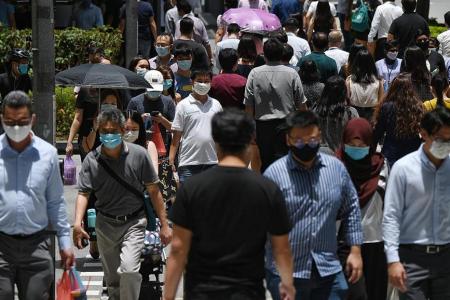Singapore sees sharpest fall in employment in 20 years
Non-residents accounted for all of decline last year but labour market on the mend
The number of workers employed fell last year in the sharpest decline in more than two decades, with foreigners bearing the brunt of the contraction, but the labour market is turning the corner.
The latest manpower data from the Ministry of Manpower (MOM) yesterday showed that non-residents accounted for all of the employment decline last year.
Meanwhile, resident employment, comprising Singaporeans and permanent residents, rebounded to slightly above pre-Covid-19 levels by the year end.
Unemployment rates also began to fall after hitting a high of 3.5 per cent for the year in September for the overall workforce, 4.9 per cent for citizens and 4.8 per cent for residents. By December, this had fallen to 3.3 per cent overall, 4.5 per cent for citizens and 4.4 per cent for residents.
These latest figures show that the economy and the labour market have been on the mend since the fourth quarter of last year, said Manpower Minister Josephine Teo after a visit to Giant Hypermarket in Tampines. "But I think it is wise for us to keep in mind that the risk factors do remain," she added.
These risk factors include international borders remaining largely closed, which will weigh on Singapore's trade-dependent economy, and wage subsidy schemes such as the Jobs Support Scheme coming to an end.
While employment grew in sectors such as public administration and education as well as health and social services, it declined most steeply in tourism and aviation-related sectors.
Non-resident employment declined in all sectors, with the bulk in construction and manufacturing. This was mainly from a fall in the number of work permit and work pass holders by 138,800, followed by decreases in the number of S Pass holders by 26,000 and Employment Pass holders by 16,700.
On the unemployment front, the overall rate rose from 2.3 per cent in 2019 to 3 per cent last year, but did not exceed that of past recessionary levels amid the severe acute respiratory syndrome outbreak in 2003 or global financial crisis in 2009.
Among residents, the unemployment rate rose from 3.1 per cent in 2019 to 4.1 per cent last year. This was slightly higher among citizens, from 3.3 per cent in 2019 to 4.2 per cent last year.
NTUC assistant secretary-general Desmond Choo said that while the labour market has shown broad improvements on multiple fronts, the elevated long-term unemployment rates remain a worry.
"This is something that we must pay attention to as structural changes to our economy continue to accelerate due to Covid-19."
Get The New Paper on your phone with the free TNP app. Download from the Apple App Store or Google Play Store now

